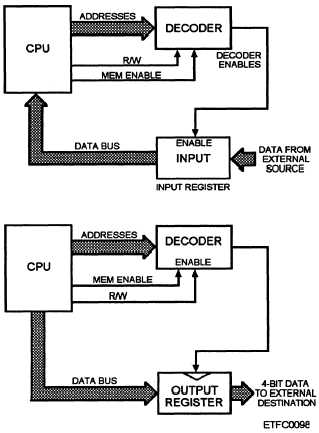different; but in addition, I/O operations include not
only digital ICs, but also linear ICs. The linear IC
circuits are the first and last type of circuitry the
information interfaces with when entering and leaving
the computer. In this topic, we discuss some of the more
common circuits you will encounter when dealing with
I/O functions. In addition to the circuits we have
discussed in the CPU and memory sections, you must
be familiar with driver and receiver circuits (linear
ICs). Review chapter 4 of this volume and NEETS,
Module 13, Introduction to Number Systems and Logic
Circuits. They provide excellent reviews of the circuits
and their functions covered in the remainder of this
topic.
l
l
l
l
l
l
l
l
The circuits include:
Adders
Command signals (enables)
Decoders
Line drivers and receivers
Registers (includes RTC and Monitor Clock for
IOCs)
Selectors
Timing
Translators
One of the primary uses of registers in I/O
operations is to provide the interfacing between the
CPU, I/O, and memory. They enable and route control
and data information between the CPU, I/O, and
memory using the internal bus system. In a computer
with no I/O processor, a register will be designated as
either an input or output register (fig. 7-11). Decoder
circuits are used for address translation, control circuits
for governing the operation of the interface, data
registers, and status registers for information exchange.
The data registers are used to hold or buffer data during
interchanges between the very fast CPU and the slower
external equipments.
The status registers hold
information for the CPU that indicates the operating
condition and current activities of the external
equipments. We discuss external interfacing later in
this topic.
INPUT/OUTPUT FUNCTIONS
The input and output functions performed by an I/O
processor are defined and enabled through the
interpretation and execution of input/output and/or
input/output controller (I/O(C)) commands obtained
from main memory.
The I/O circuits provide the
Figure 7-11.—Computer operations with no I/O processor
using registers.
timing, control, temporary storage, routing, command
translation, and interfacing (internal and external) to
perform I/O operations.
Timing Circuits
As we discussed in the memory section, timing
circuits also will provide the enables to manage the I/O
control circuits used for I/O operations.
Some
computers use the computer’s master clock and one or
two other timing signals derived from the master clock
to control the flow of data in I/O operations; an example
of this is the timing used in microcomputers. Still other
more complex computers, such as mainframes and
minicomputers, rely on a master clock and main timing
circuits in the respective functional area (CPU, memory,
or I/O) to produce and distribute timing signals to the
I/O control circuits.
In computers with an IOC, their I/O master clock
and timing circuits operate completely independently
of the CPU timing. Their master clock is started when
the computer is initially powered on or auto restarted.
It can only be stopped or temporarily halted under
7-12


